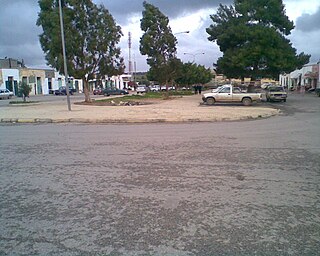This page is based on this
Wikipedia article Text is available under the
CC BY-SA 4.0 license; additional terms may apply.
Images, videos and audio are available under their respective licenses.

Misurata (Arabic: مصراتة, is a city in the Misrata District in northwestern Libya, situated 187 km to the east of Tripoli and 825 km west of Benghazi on the Mediterranean coast near Cape Misurata. With a population of about 281,000, it is the third-largest city in Libya, after Tripoli and Benghazi. It is the capital city of the Misrata District and has been called the trade capital of Libya. The harbor is at Qasr Ahmad.

Tripolitania is a historic region and former province of Libya.

Al Awaynat or Alawinat or Serdeles is a small town located in the Sahara Desert in Libya. It lies at the entrance of the Djebel Al Akakus. It is located 240 km south west of the city of Ubari and 120 km north of the city of Ghat. Al Awaynat is the gate of Tadrart Acacus and its residents from Toureg tribe.

Murqub, sometimes spelt Al Murgub or Al Marqab or al-Morqib, is one of the districts of Libya. The main city and capital is Khoms. The widely visited UNESCO World Heritage Site of Leptis Magna is also located in the district. In the north, Murqub has a shoreline on the Mediterranean Sea. On land, it borders Misrata to the east and south, Tripoli to the northwest and Jabal al Gharbi to the west.

Tarhuna wa Msalata was a district of Libya until 2007. Between 1988 and 1995 there existed the Tarhuna District, which became Tarhuna wa Msalata between 2001 and 2007. It consisted of twenty-six Basic People's Congresses, similar to townships, and its capital was Tarhuna. In the 2007 administrative reorganization the territory formerly in Tarhuna wa Msalata was transferred to Murqub District.

Zliten is a town in Murqub District of Libya. It is located 160 km to the east of Tripoli.

Musaid or Imsaad is a town in Butnan District in eastern Libya. Alternates names include: Oistant, Msa'ed, Imsa'ed, and Musa'ed. Musaid lies approximately 150 kilometres east of Tobruk and is the major border crossing between Libya and Egypt.

Mahmud al-Muntasir was the first Prime minister of Libya from March 29, 1951 to February 19, 1954, and again from January 20, 1964 to March 20, 1965. He was also the Minister of Foreign Affairs during his first term.

Castelverde, also named Gasr Garabulli, is a town in the Tripoli District (Tarabulus), of the Tripolitania region in northwestern Libya.

Massa is a town in the District of Jebel el-Akhdar in north-eastern Libya. It is located 10 km west of Beida. During Italian rule, the town was known as Luigi Razza, probably after the late Italian politician of the same name.

Qurain Abu al-Bawl is the highest point of Qatar, with an altitude of 103 metres (338 ft). It is located south of the peninsula near the border to Saudi-Arabia.

Fezzan Road is an asphalt road in central Libya, running from Abu Qurayn near the coast to Sabha in the Sahara Desert. It is 620 km (385 mi) long.

Voice of Free Libya is the name used by three radio stations aligned to the anti-Gaddafi forces that began broadcasting in February 2011, operating from the cities of Benghazi, Bayda and Misrata. They played an important role in the Libyan Civil War and have continued to broadcast after the fall of Gaddafi.
Fawzi Abdel A'al is a prosecutor and a Libyan politician born in the city of Misrata in 1971. He was named Interior Minister on 22 November 2011 by Abdurrahim El-Keib. Prior to the 2011 Libyan civil war Fawzi worked as a prosecutor at the Misratta Central Court. Fawzi lost one of his brothers during the 2011 civil war. On 26 August 2012, he resigned from his post due to criticisms against him concerning the attacks on Sufi Muslim shrines and other violent events that occurred in Libya.
Ali Ihmayda Ashour Shaaban, M.A., (Arabic is a judge and a Libyan politician. Born in the city of Khoms, he was named Justice Minister on 22 November 2011 by Abdurrahim El-Keib. Prior to the 2011 Libyan Civil War, Ali Ashour was a chancellor at Misrata Central Court.

Buerat, or Buerat el Hussoun, is a village in western Libya, some 90 km (56 mi) west of Sirte.

Al Fejeij, or Al Fjeij is an oasis in southwestern Libya. It is located 52 km (32 mi) east of Ubari, on the crossroads between Sabha-Ubari road, and the south road to Tesawa, and Murzuk.

The Libya Shield Force is an armed organisation formed in 2012 out of anti-Gaddafi armed groups spread throughout Libya. The Libyan parliament designated much of the Libya Shield Force as terrorist and elements of the Libya Shield Force were identified as linked to al-Qaeda as early as 2012.

















